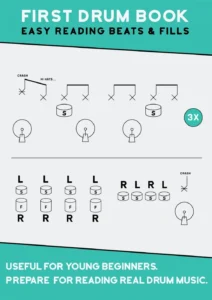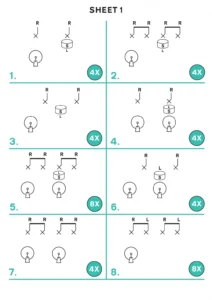Introduction:
Learning to play the drums is an exciting journey that unleashes your creativity and musical expression. Whether you’re inspired by the thunderous beats of rock or the rhythmic patterns of jazz, mastering the drums requires dedication, practice, and a solid foundation. In this beginner’s guide, we’ll explore essential tips and techniques to get you started on your drumming adventure.
- Start with the basics:
Before diving into complex rhythms and fills, it’s crucial to familiarize yourself with the basic drumming components. These include the bass drum, snare drum, hi-hat, and cymbals. Learn their names, understand their functions, and get comfortable with their placements. Practice hitting each drum individually to develop a sense of sound and coordination.
- Proper technique:
Developing good drumming technique from the beginning will save you from bad habits and potential injuries in the future. Pay attention to your posture by sitting straight and relaxed, with your feet flat on the pedals. Hold the drumsticks with a loose grip, allowing them to rebound naturally off the drumheads. Practice using wrist movements rather than relying solely on your arms, as it provides better control and endurance.
- Mastering basic beats:
To build a strong foundation, start by learning basic beats. Begin with a simple four-beat pattern using the bass drum on beats one and three, and the snare drum on beats two and four. This beat is commonly known as the “rock beat” and is a fundamental rhythm in many music genres. Experiment with different variations and gradually increase your speed as you become comfortable.


- Develop coordination:
Drumming requires excellent coordination between your hands and feet. Start by practicing rudiments, which are repetitive patterns that help you develop dexterity and control. Begin with the single-stroke roll, double-stroke roll, and paradiddle. Practice these patterns slowly at first, gradually increasing your speed as your muscle memory improves.
- Timing and counting:
Timing is everything in drumming. Develop a strong sense of timing by practicing with a metronome or playing along with your favorite songs. Counting aloud while you play can also help you internalize the rhythm and maintain a steady beat. Focus on playing precisely on the beats and syncing your hits with the rest of the music.
- Experiment with different styles:
Once you have a solid foundation, explore different drumming styles to broaden your musical vocabulary. Experiment with genres like rock, jazz, funk, blues, and Latin rhythms. Listen to drummers from various bands and genres to understand their unique playing styles and techniques. This exploration will help you find your own voice and develop your drumming identity.
- Practice regularly:
Consistency is key when learning any instrument, including the drums. Set aside dedicated practice time every day or a few times a week. Even short practice sessions can be effective if they are consistent. Focus on refining your technique, learning new patterns, and expanding your repertoire. Regular practice will ensure steady progress and help you build confidence as a drummer.
Conclusion:
Learning to play the drums is a thrilling and rewarding experience. Embrace the journey, stay patient, and enjoy the process of developing your skills. Remember, practice makes perfect, so invest time in honing your technique, exploring various styles, and building your rhythmical prowess. With dedication and perseverance, you’ll soon find yourself grooving along to your favorite tunes, creating your own beats, and discovering the boundless joy of drumming
5 tips to play drums for beginners


Certainly! Here are five essential tips to help beginners get started on their drumming journey:
- Start with a solid foundation: Before diving into complex rhythms, focus on building a strong foundation. Familiarize yourself with the different parts of the drum kit, such as the bass drum, snare drum, hi-hat, and cymbals. Practice hitting each drum individually to develop a sense of sound and coordination. This will help you become comfortable with the basic setup and prepare you for more advanced techniques.
- Master proper technique: Developing good drumming technique from the beginning is crucial. Sit with correct posture, keeping your back straight and your feet flat on the pedals. Hold the drumsticks with a loose grip, allowing them to rebound naturally off the drumheads. Focus on using your wrists for controlled movements, rather than relying solely on your arm strength. Learning proper technique early on will prevent bad habits and allow you to progress more effectively.
- Start with basic beats: Begin your drumming journey by learning basic beats. Start with simple rhythms like the rock beat, which involves hitting the bass drum on beats one and three, and the snare drum on beats two and four. Practice these beats slowly and consistently until they become comfortable. As you progress, experiment with different variations and gradually increase your speed.
- Develop coordination: Drumming requires coordination between your hands and feet. Dedicate time to practicing rudiments, which are repetitive patterns that improve dexterity and control. Start with basic rudiments like the single-stroke roll, double-stroke roll, and paradiddle. Begin slowly and focus on accuracy and coordination. As you become more comfortable, increase the tempo gradually. Regular practice will help you develop the muscle memory necessary for fluid drumming.
- Play along with music: Playing along with your favorite songs is an excellent way to improve your timing and groove. Start by playing along with recordings or using drumming apps that provide backing tracks. Pay close attention to the rhythm and feel of the music and try to replicate it on your drum kit. As you progress, you can challenge yourself with songs of increasing difficulty. Playing along with music not only enhances your skills but also makes practice more enjoyable.
Remember, consistency and patience are key when learning to play the drums. Set aside regular practice sessions, even if they are short, to maintain steady progress. Focus on gradually building your skills, experimenting with different styles, and enjoying the journey of becoming a drummer. With dedication and practice, you’ll develop your own unique style and find endless joy in playing the drums.


Very good lesson… Please send practice sheet for practice
Wow I love this.
thank you